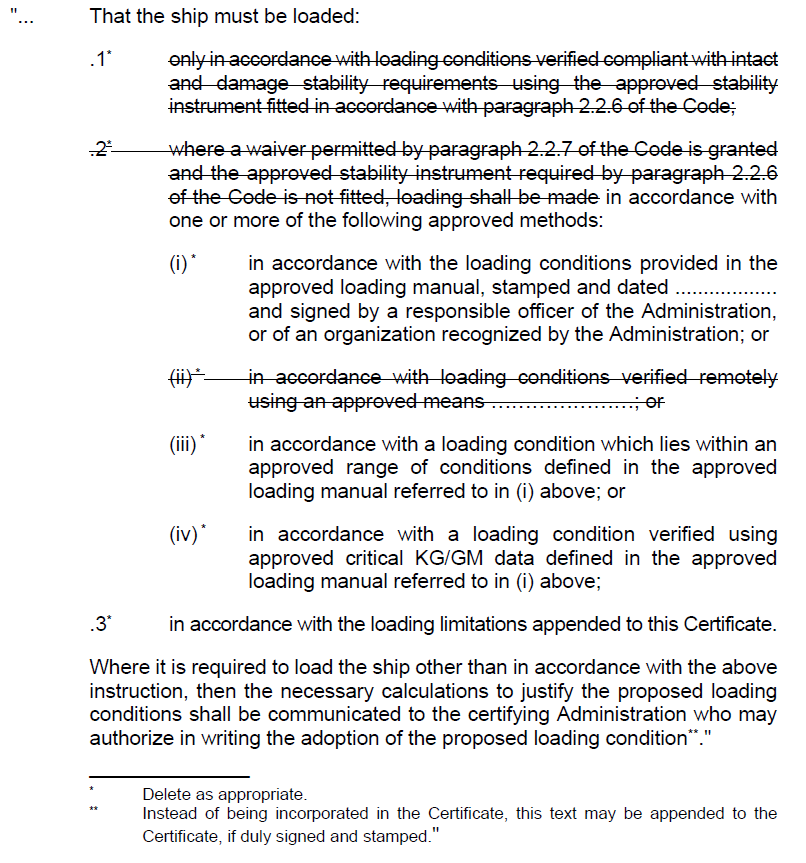Introduction
1 The Marine Environment Protection Committee (MEPC), at its
sixty-sixth session (31 March to 4 April 2014), adopted amendments to MARPOL Annex
I, the International Code for the Construction and Equipment of Ships Carrying
Dangerous Chemicals in Bulk (IBC Code) and the Code for the Construction and
Equipment of Ships Carrying Dangerous Chemicals in Bulk (BCH Code) by resolutions
MEPC.248(66), MEPC.250(66) and
MEPC.249(66), respectively. The aforementioned amendments introduced,
inter alia, changes to the Form of IOPP Certificate and Supplements, the Model form
of International Certificate of Fitness of the Carriage of Dangerous Chemicals in
Bulk and the Model form of Certificate of Fitness for the Carriage of Dangerous
Chemicals in Bulk, to reflect the requirements for a stability instrument capable of
verifying compliance with intact and damage stability requirements.
2 The Maritime Safety Committee, at its ninety-third session
(14 to 23 May 2014), adopted the same amendments to the IBC and BCH Codes as above
(see resolutions MSC.369(93) and MSC.376(93), respectively), together with corresponding amendments to
the International Code for the Construction and Equipment of Ships Carrying
Liquefied Gases in Bulk (IGC Code), the Code for the Construction and Equipment of
Ships Carrying Liquefied Gases in Bulk (GC Code) and the Code for Existing Ships
Carrying Liquefied Gases in Bulk (EGC Code) (see resolutions MSC.370(93) and MSC.377(93) and annex 13 to document MSC 93/22/Add.1, respectively).
Requirement for loading and stability information manual/booklet
3 The requirement for a ship to be supplied with an approved
loading and stability information manual/bookletfootnote also holds when the ship has been fitted
with an approved stability instrument.
Certificates issued to ships that need not yet comply with the requirement to
be fitted with an approved stability instrument
4 There are
circumstances in which a ship constructed before 1 January 2016 may need to have its
Certificate of Fitness reissued on or after 1 January 2016 but before 1 January 2021
and before the ship's first scheduled renewal survey in the aforementioned five-year
period (e.g. at a change of flag or when the cargoes to be carried are changed).
Given that the date of compliance with the requirement for having been fitted with
an approved stability instrument will not have been reached yet for that particular
ship, the ship may not be fitted with an approved stability instrument.
Consequently, the Certificate of Fitness under the IBC, BCH, IGC, GC and EGC Codes,
as applicable, should be issued with certain lines struck through, as shown below,
in addition to striking through the options that do not apply (taking into account
that Notes could be added to the certificate to facilitate clarification):

References to amending resolutions
5 For gas carriers to which the IGC Code applies and for
chemical tankers to which the IBC Code applies, the Certificate of Fitness must
refer to all the resolutions by which amendments to the Codes were adopted and with
which the ship fully complies. The three subparagraphs below contain recommendations
on how the relevant resolutions can be comprehensively referenced in the Certificate
of Fitness without explicitly listing all of the resolutions:
-
.1 for chemical tankers to which the IBC Code applies: by
stating "All up to and including [the latest resolution]", where "[the
latest resolution]" is replaced with the identifier of the applicable
resolution;
-
.2 for gas carriers to which the IGC Code applies that comply
with resolution MSC.5(48), as amended by resolutions MSC.17(58),
MSC.30(61), MSC.32(63), MSC.59(67), MSC.103(73), MSC.177(79) and MSC.220(82) and with the stability instruments
provisions provided in resolution MSC.370(93): by stating "All applicable
requirements contained in resolutions up to and including resolution
MSC.220(82) and the requirements in paragraph
2.2.6 or 2.2.7 of the IGC Code, as amended by resolution MSC.370(93)"; and
-
.3 for gas carriers to which the IGC Code applies that comply
voluntarily with all the requirements of the IGC Code, as amended by
resolution MSC.370(93): by only stating "resolution MSC.370(93)", since the voluntary compliance can
be identified by the keel-laying date on the certificate.